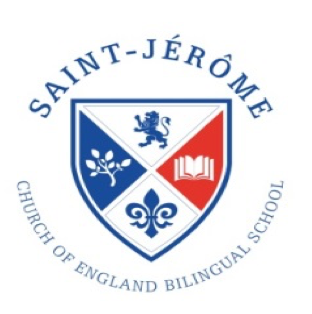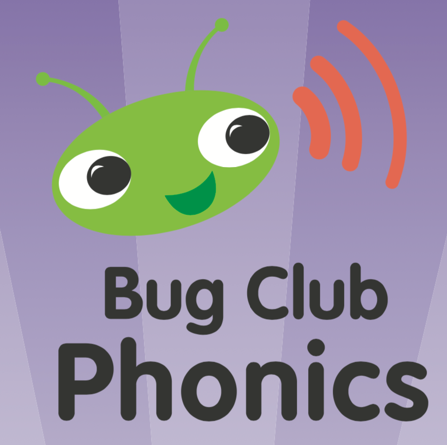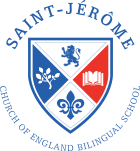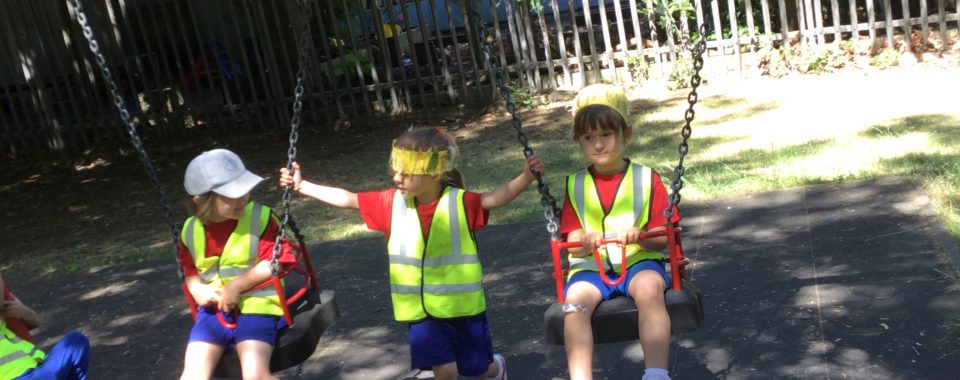Phonics

St. Jérôme
Church of England
Bilingual Primary School

Phonics Bug Scheme
and
Early Reading Development Policy
In November 2023, Mrs Wilson, our Phonics lead, delivered a workshop for parents covering the following topics:
- What is Phonics?
- Why do we use this method for teaching?
- School resources
- Assessment
- Intervention
- How to support your children
Please watch these videos and read the text below to help you understand our Phonics programme.
Part 1
Part 2
September 2020- September 2023
In EYFS and KS1 we use the approved government scheme Phonics Bug which is based on the Letters and Sounds programme. At St. Jérôme we intend to develop the children’s phonological awareness, ability to segment and blend words and read tricky words by sight in order to become fluent readers.
Aims:
- Deliver high-quality phonic teaching which secures the crucial skills of word recognition that, once mastered, enable children to read fluently and automatically enable them to concentrate on the meaning of the text
- To establish consistent practice, progression and continuity in the teaching and learning of phonics and spelling throughout the school
- To support pupils with targeted, differentiated phonics and spelling work, in addition to the whole class teaching, so that all children are given sufficient support to progress and experience challenge at a level at which they can succeed.
- To give children word work strategies that will enable them to become fluent readers and confident writers
Beginner readers should be taught:
- grapheme–phoneme correspondences in a clearly defined sequence outlined in appendix 1.
- to apply the highly important skills of blending (synthesising) phonemes in the order in which they occur
- to apply the skills of segmenting words into their constituent phonemes to spell
- that blending and segmenting are reversible processes
High-quality Phonics Bug sessions will:
- engage children in a range of activities and experiences to develop their speaking and listening skills and phonological awareness
- provide multi-sensory activities to enliven core learning
- enable children to explore a variety of fiction and non-fiction books that are 100% decodable books
- entail fun, interactive videos and activities with games and pictures
- support children in their reading, spelling and writing skills
- follow the Bug club lesson progression outlined in appendix 2.
Programme of Teaching Expectations
Phonics Bug is taught in reception to year 2, daily for up to 30 minutes. Children are taught in whole class sessions to ensure children are taught age-related phonics. Additional phonics intervention is given for children who need targeted support of earlier phonics with a member of staff trained in delivering high quality phonics, using phonics bugs games and lessons resources.
Reception – We aim for all children to have completed phase 4 by the end of Reception.
Year One – We aim for all children to have completed phase 5 by the end of Year One.
Year Two – We aim for all children to be working securely within phase 6 by the end of Year Two.
Key Stage Two (Year 3 – Year 6) – Further phonics interventions for children who are not yet secure in phase 6 phonics will be tailored to meeting their needs and delivered by a member of staff trained in delivering high quality phonics, using phonics bugs games and lesson resources.
Assessment and Tracking
At the end of each term (three times per year) children will be assessed on their progress using the phonics bug assessment sheets. These assessments will be used to track how children are progressing and which areas need to be retaught to specific groups of children through additional intervention. At the end of the academic year, the class teacher passes on the end of year phonics data to the next class teacher stating where the children are within the Phonics Bug programme. This data will provide teachers with possible next steps for children to build on their personal phonics development.
National Phonics Screening Test
All children in Year One will be screened using the National Assessment materials in Summer Term. If children in Year One do not pass the screening test, they will be retested when they are in Year Two. This data will be submitted to the Local Authority. Reception children will attempt a mock phonics screening check at the end of summer term. They will then complete another screening check half termly throughout year 1 to ensure progress towards the screening.
2020-2021 – Due to school closures in the Summer Term of 2019-2020, the children who did not complete the phonics screening in year one will be testing in the Autumn Term of year 2. Those who do not pass the phonics screening test will have another chance to pass it in the Summer Term.
Home reading
Bug Club is a finely levelled, progressive phonics-based reading scheme, which ensures that each child can find a book at exactly the right level for them. Home reading books are graded into colour units in accordance to the Phonics Bug teaching scheme, where there is a carefully planned progression of books. This progression gives children plenty of opportunity to develop their reading skills and master each step while moving through the reading programme. Children will progress through the colour bands once they have achieved two goals
- That they are able to decode and fluently read the words playing close attention to punctuation.
- That they are able to answer retrieve explicit information from the text and are also able to infer meaning out less explicit details.
Online access
Each child in Reception to Year 6 have access to an online account for Phonics Bug Active Learn. Each child has a personalised homepage where they’ll find the eBooks they’ve been allocated by the teacher and motivating rewards. The online reading world ensures children can access independent reading resources anywhere at any time.
Appendix 1 Phonics Bugs Progression
| Phase | Unit | Focus | Decodable Words | Non-decodable Words |
|
2 |
1 | s a t p | at, as | |
| 2 | i n m d | an, it, in, is, dad | ||
| 3 | g o c k | can, on, not, got | to | |
| 4 | ck e u r | mum, up, get | the, no, go | |
| 5 | h b f ff l ll ss | had, back, his, big, him, if, of, off, but | I, into | |
|
3 |
6 | j v w x | will | me, be |
| 7 | y z zz qu | he, my, by | ||
| 8 | ch sh th ng | that, this, then, them, with | they, she | |
| 9 | ai ee igh oa oo/oo | look, see, too | we, are | |
| 10 | ar or ur ow oi | for, now, down | you, her | |
| 11 | ear air ure er | all, was | ||
|
4 |
12 | Adjacent consonants
(cvcc, ccvc, ccvcc, cccvc, cccvcc) |
went, from, children, just, help | said, have, like, so, do, some, come, were, there, little, one, when, out, what |
|
5 |
13 | zh wh ph | oh, their | |
| 14 | ay a-e eight/ey/ei (long a) | Mr, Mrs | ||
| 15 | ea e-e ie/ey/y (long e) | looked, called, asked | ||
| 16 | ie i-e y (long i) | water, where | ||
| 17 | ow o-e o/oe (long o) | who, again | ||
| 18 | ew ue u-e (long u) u/oul (short u) | thought, through | ||
| 19 | aw au al | work, laughed, because | ||
| 20 | ir er ear | Thursday, Saturday, thirteen, thirty | ||
| 21 | ou oy | different, any, many | ||
| 22 | ere/eer are/ear | eyes, friends | ||
| 23 | c k ck ch | two, once | ||
| 24 | ce/ci/cy sc/stl/se | great, clothes | ||
| 25 | ge/gi/gy dge | it’s, I’m, I’ll, I’ve | ||
| 26 | le mb kn/gn wr | don’t, can’t, didn’t | ||
| 27 | tch sh ea. (w)a o | first, second, third | ||
|
6 |
28 | Suffix endings: -ing -ed (morphemes) | clearing, gleaming, rained, mailed | |
| 29 | Suffix plurals: -s -es (plural morphemes) | man/men, mouse/mic, foot/feet, tooth/teeth, sheep/sheep | ||
| 30 | Prefix morphemes: re- un- | vowel, consonant, prefix, suffix, syllable | ||
Appendix 2 Phonics Bugs Lesson Sequence
Bug Club Phonics is structured with Phoneme Sessions and Language Sessions. This structure fully supports the daily phonics teaching sequence recommened by the Primary National Strategy in the renewed Framework. The following diagram illustrates the alignment of the Bug Club Phonics lesson structure to this teaching sequence .
| Recommended Teaching Sequence |
Bug Club Phonics Lesson Structure |
| Introduce | Learning intentions and outcomes for the day are discussed at the start of the lesson |
| Revisit and Review | Every Phoneme Session begins with Revision to review previous learning. In Reception the Revision is not just of the previous day’s target grapheme-phoneme correspondence, but also of blending for reading and segmenting for spelling of the relevant words.
In Key Stage 1 the Revision is sometimes a review of previous learning with links with the planned teaching for that day. |
| Teach | Every Phoneme and Language Session is composed of Teaching Elements (e.g. Sounds, Reading, Spelling etc) which are easily navigated to structure the new phonic teaching.
The teaching of grapheme-phoneme correspondences and high-frequency (common) words is covered. |
| Practice | Practice opportunities are available in the following areas: 1/ ‘Follow-up’ parts of the lessons 2/ Unit-linked pupil games 3/ Unit-linked photocopy masters 4/ ‘Free-teaching’ within the software’s Magnetic Board |
| Apply | Language Sessions provide opportunities to apply developing phonic skills to the reading, spelling and writing of captions and sentences. This application also covers irregular (not fully decodable ) common words. In addition, phonic skills can be applied when using the linked decodable readers, starting as early as Unit 2 of Bug Club Phonics. |
| Assess Learning | Assessment guidance and materials provided within this guide and in the software enable ongoing formative assessment during the daily lessons and summative assessment at regular periods through the programme The Bug Club Phonics Prepare and Assess Handbook and online resources can be used to prepare children for the Phonics Screening Check in Year 1. |

